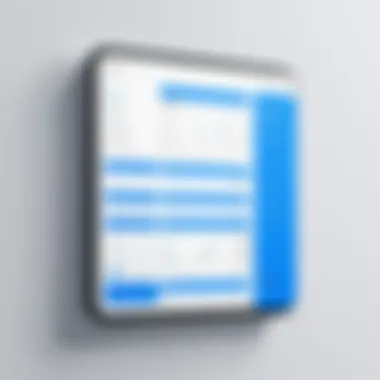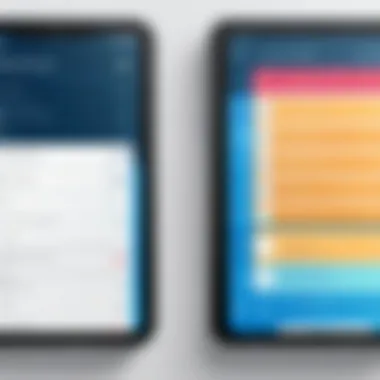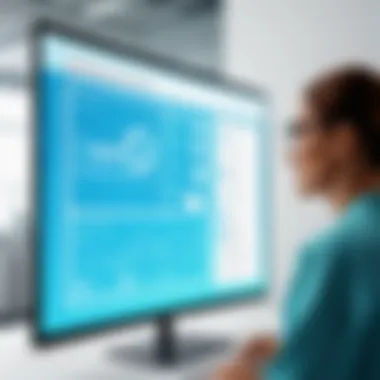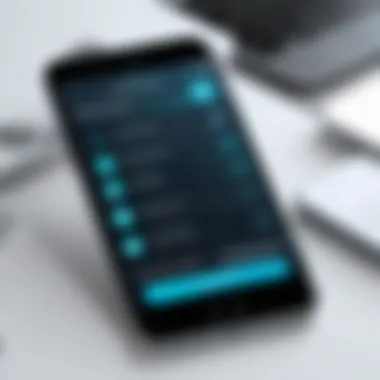Healthcare Appointment Reminders: Enhancing Patient Engagement


Intro
Healthcare appointment reminders serve as an essential element in the integration of technology into patient care. They aim to improve communication, enhance patient engagement, and ultimately increase attendance rates for scheduled medical appointments. In a sector where missing an appointment can lead to negative consequences for both patients and healthcare providers, the significance of effective reminder systems becomes apparent.
Over the years, traditional methods such as phone calls and postal reminders have evolved into sophisticated digital solutions. These innovations not only cater to varied patient preferences but also enhance the operational efficiency of healthcare providers. The sheer variety of options available makes it crucial for decision-makers and IT professionals to thoroughly understand the landscape of appointment reminders.
This examination will navigate through the functionalities that define these systems, analyze the pricing models available, and equip stakeholders with the knowledge necessary to make informed decisions regarding their implementation. Such insights will clarify how reminders contribute to improved healthcare outcomes and patient satisfaction.
Prelims to Healthcare Appointment Reminders
Healthcare appointment reminders have become a crucial element in the patient management process. They serve not just as notifications, but as valuable tools to enhance patient attendance and engagement. The growing emphasis on efficiency in healthcare delivery systems has shifted the focus toward creating a seamless experience for patients. This section will explore the various dimensions of appointment reminders, from their significance in reducing no-show rates to the historical developments that have shaped their current forms.
Importance of Appointment Reminders
Appointment reminders play a pivotal role in enhancing the overall patient experience within healthcare systems. They help reduce the rate of no-shows, which can significantly affect healthcare providers' operational efficiency and revenue. By implementing a robust appointment reminder system, organizations can foster better patient relationships. This is achieved through timely reminders that allow patients to manage their schedules effectively. Furthermore, appointment reminders can include essential information such as location, preparation instructions, and follow-up contacts, ensuring that the patient is fully informed.
"Efficient appointment reminders can lead to improved patient satisfaction and higher compliance with recommended health follow-ups."
In addition to operational benefits, appointment reminders contribute to better health outcomes. Patients who are reminded are less likely to miss important appointments, leading to earlier diagnosis and more effective treatment plans. Thus, the implementation of a well-structured reminder system is no longer a luxury; it's a necessity in modern healthcare environments.
Historical Context of Appointment Reminders
The roots of appointment reminders can be traced back to traditional methods such as phone calls and paper mail notifications. In the past, healthcare providers relied heavily on manual systems, often leading to inefficiencies and communication gaps. With the advent of technology, particularly in the late 20th century, the landscape began to change. The introduction of computers and telecommunication systems allowed for more streamlined approaches to managing patient appointments.
The shift towards digital solutions began in the early 2000s with the rise of automated phone systems that could send out reminders. Soon after, text messaging and email became viable options for appointment notifications, leveraging the growing prevalence of mobile phones and the internet. Today, healthcare organizations utilize sophisticated software that integrates with electronic health records, creating a cohesive communication channel that helps patients stay informed about their appointments.
In summary, the evolution of appointment reminders reflects the broader transformation within the healthcare system. From rudimentary notifications to advanced digital solutions, these reminders now play an essential role in shaping patient care and operational efficiency.
Types of Appointment Reminders
Understanding the various types of appointment reminders is essential in the realm of healthcare. They assist in reducing missed appointments, which leads to better patient outcomes and operational efficiency. Different reminder systems cater to diverse patient preferences and technological access.
Traditional Reminder Methods
Paper Mail Notifications
Paper mail notifications have been a staple in healthcare communications. These are physical postcards or letters sent directly to the patient’s home. Their main contribution to appointment reminders lies in the tangible aspect they provide. Some individuals respond well to physical reminders that they can hold.
A key characteristic of paper mail notifications is their simplicity. They do not require any digital device or internet access, making them a suitable choice for patients who may not be tech-savvy. Additionally, for many older adults, having a paper reminder can feel more personal and trustworthy.
However, these notifications come with disadvantages. They can be costly to produce and send, and there's the risk of them getting lost in the mail. Moreover, the time it takes for delivery means that reminders must be sent well in advance, potentially leading to inefficiencies.
Phone Call Reminders
Phone call reminders are another traditional method that remains effective. This involves a staff member, or an automated system, calling the patient to remind them of their upcoming appointment. The direct interaction often provides immediate confirmation of the appointment. This method takes advantage of the personal touch, as patients can ask questions or verify details during the call.
A major advantage of phone reminders is the ability for real-time interaction. Patients who need additional information or have specific concerns can address them instantly. However, the downside lies in the time and resources required to make these calls, particularly in busy practices. There is also the issue of patients missing the call, leading to the potential for communication breakdown.
Digital Reminder Solutions
Digital solutions for appointment reminders have gained prominence in recent years. They offer efficiency and convenience in a rapidly advancing technological landscape.
Text Messaging Services
Text messaging services are increasingly popular for appointment reminders. They provide a quick and efficient way to reach patients who often carry smartphones. The value of a simple text reminder helps bridge the communication gap, especially for younger demographics. Many people prefer texts over calls due to the immediacy and privacy they offer.


Text messages can include important information such as appointment details and options to confirm or reschedule at the patient’s convenience. Nevertheless, there are challenges, including ensuring that the message does not get lost among other notifications and potential issues with data privacy.
Email Confirmations
Email confirmations are another avenue for appointment reminders. They offer patients a detailed overview of their scheduled appointments in a format they can easily refer back to. This method allows for including helpful links and attachments, such as forms that patients can fill out in advance.
The main advantage of email is the ability to communicate a great deal of information in one message. However, the effectiveness depends on whether patients consistently check their emails. The risk of emails being overlooked can diminish their impact.
Mobile App Notifications
Mobile app notifications are the latest advancement in appointment reminders. Many healthcare institutions now develop dedicated applications to manage patient interactions. These apps can send instant notifications directly to the users’ devices.
One of the unique features of mobile app notifications is their customizable nature. Patients can set preferences for how they receive information. Mobile apps can send reminders with interactive features, such as links to reschedule or contact the office easily. However, the major drawback is that these solutions require patients to download and engage with the application, which can be a barrier for some.
In summary, having a variety of appointment reminder types is essential for catering to different patient needs and preferences. The effectiveness of reminders often depends on a hospital's or clinic's ability to integrate these methods into a cohesive communication strategy.
Effectiveness of Appointment Reminder Systems
The effectiveness of appointment reminder systems is crucial to improving healthcare delivery and patient satisfaction. With growing concerns over missed appointments, these systems serve as a vital tool for healthcare providers. They not only aim to raise patient attendance rates but also enhance communication between healthcare professionals and patients. Numerous factors underscore their importance, including patient adherence to scheduled appointments, efficient use of resources, and related operational costs.
Impact on Patient Attendance Rates
Statistical Evidence
Statistical evidence plays a pivotal role in assessing the effectiveness of appointment reminder systems. Research studies indicate significant improvements in patient attendance rates when reminders are employed. One key characteristic of this evidence is its quantitative nature, which provides concrete data supporting the claim that reminders work. For example, a study might show an increase in attendance rates by 20% among patients receiving text message reminders compared to those who do not. This feature makes statistical evidence a compelling choice for demonstrating the benefits of appointment reminders.
Additionally, the reliance on data helps practitioners make informed decisions regarding their engagement strategies. However, it is crucial to recognize potential biases in study designs that might influence results. Over-reliance on specific data sets can sometimes lead to oversimplification of the effectiveness of reminder systems.
Case Studies
Case studies offer real-world insights that enrich our understanding of appointment reminder systems. They highlight specific scenarios where implementations led to measurable outcome improvements. The key characteristic of case studies is their depth, allowing for a thorough exploration of how appointment reminders affected various healthcare settings. For instance, a hospital might document improved attendance rates after rolling out an automated phone call system for patients. This example underlines the adaptability and effectiveness of reminders in diverse settings, showcasing a beneficial aspect for various healthcare providers.
Each case study typically contains unique features, such as demographic details, which can reveal trends like age or patient type impacting reminder effectiveness. These characteristics help in tailoring solutions for different populations. However, generalizing findings from case studies needs caution, as individual circumstances may not apply universally.
Patient Engagement Through Reminders
Patient engagement is another important aspect facilitated by appointment reminders. This engagement goes beyond mere attendance; it fosters a deeper connection between patients and healthcare providers. When reminders are used effectively, they empower patients to take charge of their health by reminding them about their appointments. This process ultimately enhances the likelihood of following up with treatments or care plans.
Moreover, reminders can be personalized to specific patient needs, making them more dynamic. For instance, integrating specific health tips within reminders can encourage preventive care, thus enhancing overall health literacy. A thoughtful approach to reminders increases perceived value among patients, leading to proactive health behaviors.
Technological Advancements in Reminders
Technological advancements play a critical role in the evolution of healthcare appointment reminders. They enhance the ability of healthcare providers to connect with their patients efficiently. The shift from traditional methods to digital solutions has resulted in significant improvements in patient attendance rates and engagement. These advancements streamline the appointment reminder process and support better management of patient information.
Integration with Healthcare IT Systems
Electronic Health Records
Electronic Health Records (EHRs) serve as a foundational element in the integration of appointment reminders. They provide a centralized and comprehensive view of a patient’s medical history, which is crucial for effective communication. The key characteristic of EHRs is their ability to store extensive patient data in a digital format, allowing healthcare providers to access information quickly. This makes it a beneficial choice for appointment reminders, as providers can easily send notifications based on the most current patient information.
One unique feature of EHRs is their capacity for automated reminders based on appointment schedules. This automation helps minimize the workload on administrative staff, reducing the chances of errors in notifying patients. However, the implementation of EHRs requires careful attention to data privacy concerns, which can be a disadvantage if not managed properly. In the context of appointment reminders, the advantages largely outweigh the potential drawbacks, contributing positively to overall healthcare efficiency.
Practice Management Software
Practice Management Software (PMS) enhances the operational efficiency of healthcare facilities by coordinating various administrative tasks, including appointment scheduling. A key characteristic of PMS is its ability to integrate scheduling with billing and patient records. This comprehensive view ensures that the entire appointment process is seamless. The use of PMS for appointment reminders is particularly popular, as it enables tailored notifications specific to each patient’s needs and preferences.
One unique feature of PMS is its customizable reminder settings, which allow for the adjustment of notification frequency and channels. This flexibility can enhance patient adherence, ensuring that reminders reach them through their preferred mediums, be it text, email, or phone call. Nevertheless, the reliance on technology can present challenges. For instance, small practices may find the cost of implementing sophisticated PMS systems prohibitive. Despite this, the benefits of improved patient communication and operational efficiency often justify the investment.


Artificial Intelligence in Appointment Management
Artificial Intelligence (AI) is revolutionizing appointment management by offering intelligent systems that predict, schedule, and remind patients of their appointments. AI can analyze patient behavior and preferences, leading to more effective and personalized reminders. This predictive capability enhances patient engagement, as reminders can be sent at optimal times based on data patterns.
Moreover, AI-driven systems can handle patient queries, reducing the burden on administrative staff. This technology not only improves efficiency but also provides a better patient experience by ensuring that information is available in a timely manner.
Best Practices for Implementing Appointment Reminders
Implementing effective appointment reminders is crucial for maximizing patient attendance and engagement. This section outlines the best practices that healthcare providers can adopt to ensure that their reminder systems work efficiently. Making the process as seamless as possible improves communication between patients and providers, ultimately enhancing overall healthcare outcomes.
Personalization of Reminders
Personalization of reminders is key to increasing their effectiveness. Tailored messages resonate more with patients, making them feel valued and understood. For instance, reminders can include the patient’s name, appointment date, and even specific instructions regarding health preparations or location details. This level of customization reduces confusion and enhances the likelihood of attendance.
Benefits of personalization include:
- Increased patient engagement.
- A reduction in no-show rates.
- Higher satisfaction with the healthcare experience.
Moreover, understanding each patient's preferences for receiving reminders—whether via text, email, or phone call—further nurtures this relationship.
Timing of Reminders
Timing is a critical factor in the success of appointment reminders. Sending them at the right moment can significantly influence a patient’s decision to attend.
Optimal Frequency
The optimal frequency of reminders balances the need to inform without overwhelming patients. Research suggests that sending a reminder too early may lead to forgetfulness, while sending it too late might not allow adequate preparation time. Generally, two well-timed reminders are preferred: one a week before and another a day before the appointment.
Characteristics of optimal frequency include:
- Effectiveness: Engages patients with timely information.
- User-Friendly: Fits into patients' schedules without causing annoyance.
One unique feature of this approach is the adaptive nature of the reminders based on patient history. For example, patients who have previously missed appointments could receive additional reminders.
Scheduling Considerations
Scheduling considerations can impact the effectiveness of reminders. Factors include the type of appointment, patient demographics, and specific healthcare settings. It is essential to analyze these components before determining an optimal schedule for sending reminders.
Key characteristics of scheduling considerations involve:
- Flexibility: Allows adjustments based on patient needs and preferences.
- Contextual Awareness: Understanding the type of care being provided (e.g., a follow-up visit vs a new patient intake).
The unique aspect of scheduling is the consideration of time zones and varying busy periods within healthcare practices. For example, a patient can be reminded during less busy hours at their convenience. Ultimately, effective timing fosters a culture of accountability and reliability.
"The integration of proper timing and personalization in reminders can significantly impact patient care and operational productivity."
Overall, adhering to these best practices in implementing appointment reminders ensures a robust system that enhances patient engagement and maximizes attendance.
Challenges in Reminder Implementation
In the realm of healthcare appointment reminders, several challenges impede effective implementation. These issues arise from both technological limitations and concerns surrounding patient privacy. Understanding these challenges is essential for healthcare organizations seeking to optimize their reminder systems. Addressing these barriers not only enhances efficiency but also supports improved patient outcomes.
Technological Barriers
The rapid advancement of technology presents both opportunities and challenges for healthcare appointment reminders. Not all healthcare providers are on the same level regarding technological infrastructure. Some clinics may still rely on outdated systems that fail to integrate effectively with modern reminder solutions. This can lead to issues such as inconsistent data, delays in reminders, and increased administrative workload.


Another aspect to consider is the digital divide. Not every patient has access to smartphones or the internet. Studies show that lower-income populations may struggle with technology adoption. Therefore, healthcare providers must offer multiple reminder channels to accommodate all patients. Relying solely on digital methods could alienate a segment of the patient population.
Furthermore, technical glitches can occur, disrupting the flow of reminders. Issues like system outages or software bugs can result in important notifications not being sent. Such failures can have detrimental effects on patient attendance and trust in the healthcare system.
- Integration Issues: Difficulties in merging new technologies with existing healthcare IT systems.
- Accessibility Concerns: Patients without smartphones or internet access are at a disadvantage.
- Reliability Risks: Potential for technical malfunctions affecting reminder distribution.
Patient Privacy and Data Security
Patient privacy is another significant concern when implementing appointment reminders. The collection and storage of personal health information bring forth the responsibility of protecting that data. Any data breaches can lead to severe consequences for both patients and healthcare organizations. Such incidents may damage the reputation of a provider and erode the trust patients place in their healthcare system.
It is crucial for healthcare organizations to comply with regulations like HIPAA in the United States. These regulations mandate strict measures for data protection. Failing to adhere to these guidelines can result in legal ramifications and hefty fines.
Moreover, the methods of communication—be it text, email, or phone—must be chosen carefully to ensure that privacy is maintained. For instance, sending sensitive reminders via unsecured text messages could expose patient information to unauthorized persons.
Effective measures could include:
- Encryption: Implementing encryption protocols for data transmission to enhance security.
- Access Control: Limiting access to patient information within the organization to ensure that only authorized personnel can view sensitive data.
- Patient Consent: Involving patients in the decision-making process about how their information is used and shared can promote transparency.
"The importance of safeguarding patient data cannot be overstated. Trust is paramount in the patient-provider relationship."
In summary, overcoming technological barriers and addressing privacy concerns are essential for the successful implementation of healthcare appointment reminder systems. By doing so, healthcare providers can ensure higher patient engagement and improved attendance rates.
Future Directions in Healthcare Appointment Reminders
The landscape of healthcare appointment reminders is evolving rapidly. Understanding future directions in this field is crucial for healthcare providers. These advancements can lead to improved patient outcomes and operational efficiency. The integration of new technologies and trends is essential in enhancing the effectiveness of appointment reminders. Key factors include better personalization, the application of artificial intelligence, and the rise of telehealth.
Emerging Technologies and Trends
Emerging technologies are redefining how appointment reminders function. One notable trend is the adoption of chatbots for communication. Chatbots can interact with patients through various platforms, providing timely reminders effortlessly. Another technology is machine learning. This can analyze data patterns and optimize reminder timing based on individual patient behavior.
Moreover, voice-activated reminders are gaining traction. Devices like Amazon Alexa or Google Assistant can send reminders verbally, ensuring patients receive them directly without the need for screens.
In addition, cloud computing is enhancing data accessibility. Healthcare providers can store patient data securely and retrieve it anytime, creating a flexible reminder system. Remote patient monitoring can also serve as a tool to remind patients of appointments based on their health metrics.
The convergence of health apps with social media can facilitate reminders shared among friends and family. This shared experience can motivate patients to attend their appointments.
"Investing in innovative technologies can substantially enhance appointment reminder systems, leading to better patient engagement and satisfaction."
Patient-Centered Approaches
The shift towards patient-centered care emphasizes the need for individualized appointment reminders. This approach accounts for patients' unique preferences, ensuring they receive reminders in their preferred format and at suitable times. Conducting surveys to understand preferences is a reasonable strategy for providers.
Personalization can extend beyond mere reminders. Providing context regarding the appointment is valuable. For instance, explaining the importance of a follow-up visit can resonate more with patients than a standard reminder. This builds a connection and increases the likelihood of attendance.
Involving patients in the decision-making process about reminder systems fosters a sense of responsibility and ownership. When patients feel included, they are more likely to adhere to the reminder systems established by their healthcare providers.
Additionally, offering multilingual reminders can enhance accessibility, catering to diverse patient populations.
Culmination
The conclusion of this article serves as a crucial element that encapsulates the insights gathered throughout the examination of healthcare appointment reminders. It allows for a holistic reflection on how these reminders function and their broader implications in the healthcare ecosystem. The urgency for healthcare providers to adopt effective reminder systems is underscored, as these systems directly correlate to improved patient engagement, adherence to appointments, and ultimately, better health outcomes.
Summation of Key Insights
Appointment reminders, whether traditional or digital, play a pivotal role in enhancing operational efficiency within healthcare settings. Notably, statistics show that healthcare practices implementing various reminder strategies have seen significant improvements in patient attendance rates. This is paramount, as missed appointments not only affect patients' health but also hinder the overall efficacy of healthcare services. The analysis of case studies in earlier sections has revealed that personalized and well-timed reminders are particularly effective in increasing patient compliance.
Furthermore, emerging technologies like artificial intelligence can analyze patient data to optimize reminder systems further. These advancements enable healthcare providers to tailor messages that resonate with individual patients, thereby maximizing engagement.
Final Thoughts on Appointment Reminder Systems
Effective appointment reminders contribute to healthier populations and reduce the burden of missed appointments on healthcare systems.
Overall, this examination highlights that investing time and resources into improving reminder strategies is essential for achieving optimal healthcare delivery.















